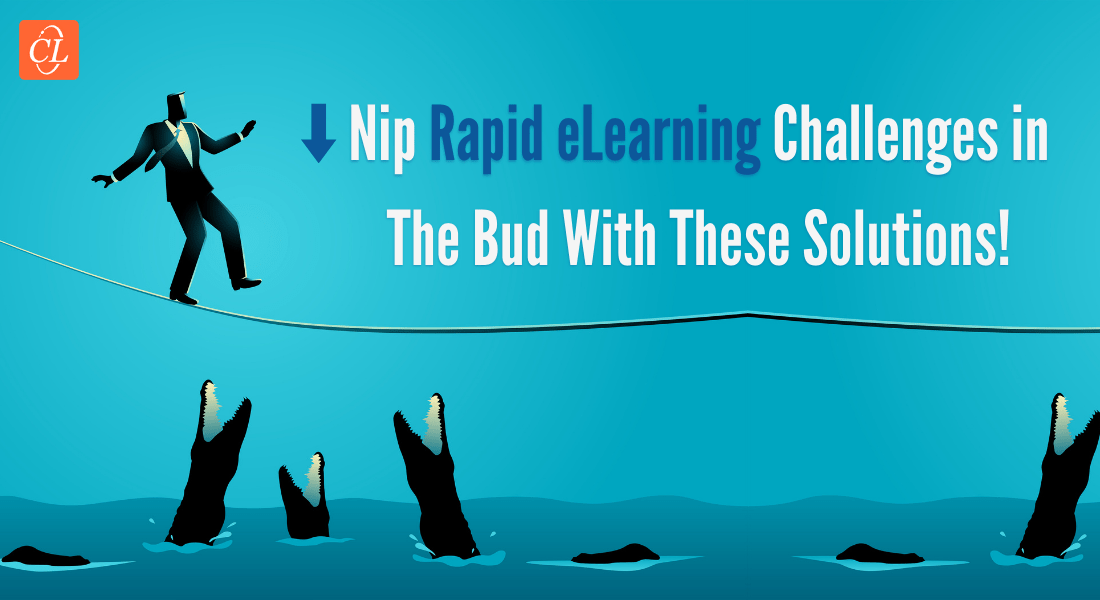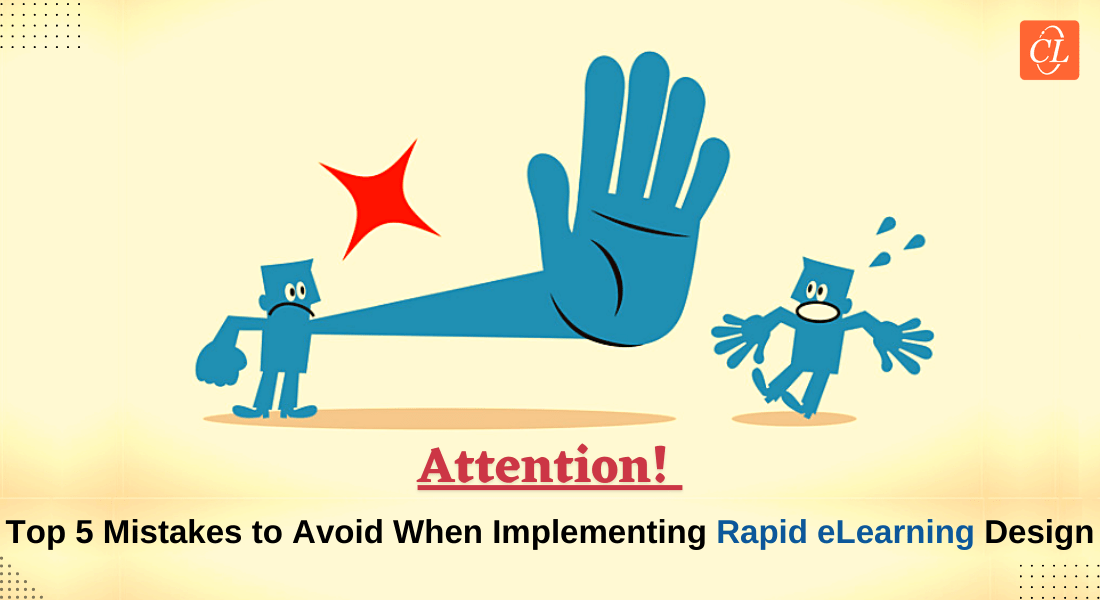6 Best Solutions to Tackle the Challenges in Rapid eLearning

Hey there! So, you’re venturing into the world of rapid eLearning, huh? Well, buckle up, my friend, because it’s a wild ride. With plenty of ups and downs along the way, rapid eLearning can be a bit like a rollercoaster. In our previous blog, we have already discussed the lows of this rollercoaster ride, i.e., the challenges in rapid eLearning in detail. And now, as promised, I bring to you the most awaited rapid eLearning solutions to ensure that you enjoy the ups of this amazing rapid eLearning development process journey. Excited?
Well, let’s accept it! Rapid eLearning challenges are enough to make even the bravest of instructional designers feel a little queasy! But where there’s a will, there’s a way! And rapid eLearning solutions are here to help you overcome these challenges and create eLearning courses that enhance your learner’s learning experience. By staying informed and being prepared, you can tackle these obstacles head-on and come out on the other side with training material that’s engaging, effective, and impactful.
Nip Rapid eLearning Challenges in The Bud With These Solutions!
Here’s the list of the best six:
- Focus on the essentials
- Seek help from SME
- Incorporate adult learning principles
- Evaluate the features and functionality of rapid authoring tools
- Invest time and resources in tech-related research
- Allocate resources toward priority components only
So, let’s recall the top challenges in rapid eLearning and then explore some solutions that help you power through. We’ll cover everything from managing your time and resources effectively to designing courses that keep your learners engaged and motivated.
Are you ready to meet the challenges with confidence because we’ve got you covered with relevant solutions?
Let’s dive in!
Solutions to Top 6 Challenges in Rapid eLearning
Challenge: Prevailing Time Constraints
Solution: Focus on the Essentials
I hear you and I totally relate to this challenge. Time constraints are a major hurdle in rapid eLearning design. It’s tough to create a comprehensive and engaging course when you’re under pressure to meet tight deadlines.
But don’t worry, here are some effective ways you can use to solve this challenge. First, focus on the essentials – what are the key learning objectives that you need to cover? Make sure you prioritize these elements and don’t get bogged down by the extras. Then consider using templates or pre-built modules to save time on rapid eLearning design and development. This helps you streamline the process and get your course up and running quickly.
If you still have some reservations or setbacks, don’t be afraid to outsource some aspects of the project when needed. Wondering why? It’s because working with a team of experts enables you to get the job done faster and more efficiently, while still ensuring that the quality of the content is top-notch.
Here’s a practical guide to help you choose the right vendor for eLearning development outsourcing.
By implementing these strategies, you can create effective and engaging eLearning courses even under tight time constraints. Don’t let the pressure get to you – with the right approach, you can rise to the challenge and deliver great results for your learners.
Challenge: Segregating Need-to-know and Nice-to-know Content
Solution: Seek Help from SME
Segregating and prioritizing content is really difficult in rapid eLearning development. Therefore, it’s important to focus only on the core content and make sure learners are getting the information they need to achieve the learning objectives and enhance their productivity.
To tackle this challenge, you should start by analyzing the pre-existing content and identifying what is essential versus what is non-essential. Focus on the key concepts and skills that learners need to master in order to succeed, and make sure those are front and center in your eLearning course.
With that said, I do understand that not every subject or concept would fall under the purview of your expertise. So don’t be afraid to collaborate with Subject Matter Experts (SMEs) or other stakeholders to ensure that you’re focusing on the right content. Their insights can help you identify what’s truly important and avoid including irrelevant information.
Want to know how to make the most of the valuble time of SMEs? Here's an infographic with some amazing tips!

Challenge: Understanding the Learner Preferences
Solution: Incorporate Adult Learning Principles
Well, let me share something with you. I have two friends. One of them loves to learn at her own pace. Whereas the other friend is a traveler and likes to learn new things on the go so they want the learning to be convenient and flexible. They both learn but in different ways! So I completely agree that understanding learner preferences is a crucial aspect of creating effective rapid eLearning courses. But how do you do that?
For starters, make sure you’re incorporating adult learning principles and instructional design strategies that are proven to be effective. This includes things like presenting content in short, manageable nuggets (known as microlearning), providing opportunities for practice and feedback, and using a variety of interactive elements to keep the learners engaged.
Moreover, to ensure that you’re catering to your learners’ needs and preferences, use surveys and focus groups to gather direct feedback from your target audience. This helps you understand their preferences for learning formats, interactive activities, assessments, and more. By getting this feedback upfront, you can ensure that your course is designed to meet their needs and expectations.
Challenge: Selecting the Right Rapid Authoring Tool
Solution: Evaluate the Features and Functionality of Rapid Authoring Tools
The right rapid authoring tool is like the sun. It makes your day clear, brighter, and cheerful! Therefore, it’s a crucial one in the rapid eLearning design process. With that said, we can’t ignore the fact that selecting the right rapid authoring tool can be a daunting task.
And to overcome this challenge, you need to first understand the specific requirements and objectives of your training program. Once you have a clear idea, then do some research on options available for rapid eLearning authoring tools. With all the information handy, finally evaluate the rapid authoring tools based on their features, functionality, and compatibility with other software and systems. Based on your requirement, you can pick the right tool.
Apart from that, while considering the rapid authoring tool, you should keep in mind the learning curve of the tool and the availability of support and resources to help you in case of any issues or challenges. In short, selecting the right rapid authoring tool requires careful consideration and evaluation. It’s important to remember that not all tools are created equal, and the right tool can make all the difference in creating a comprehensive and engaging eLearning module.
Challenge: Missing Out on Emerging Technology
Solution: Invest Time and Resources in Tech-related Research
In today’s fast-paced, innovation-driven world of business, it is important to stay updated on emerging technologies in the rapid eLearning development process. But who has the time? Well, this aspect definitely deserves your attention. So, one way is to intentionally dedicate some time and resources toward innovation and tech-related research. Following this approach, you get to learn about new technology that may be relevant and beneficial for your eLearning design and development process. It helps you stay ahead of the game and remain competitive in the ever-changing eLearning landscape.
Another way is that you can also collaborate with industry experts or training professionals who have expertise and experience in leveraging the latest technologies. By partnering with such experts, you gain valuable insights into emerging eLearning trends and technologies and learn how to effectively integrate these tools into designing and developing immersive, learner-centric rapid eLearning courses. Either way, you can ensure that your eLearning courses are cutting-edge and impactful in achieving your training goals.
Challenge: Having Limited Resources and Quality Control
Solution: Allocate Resources Toward Priority Components Only
Struggling to create effective rapid eLearning courses with limited resources is real! Especially when it influences learner engagement and quality control. However, if planned and implemented properly, you can easily overcome this challenge. Here’s how. You can leverage existing resources, such as using open-source templates or repurposing existing content to save time and resources.
Furthermore, you can use various quality control measures, such as peer reviews or learner feedback, to identify and fix any errors or inconsistencies in the course content. Moreover, you can work closely with the Subject Matter Experts (SMEs) to ensure the top-notch quality of your training material. They support in designing and delivering accurate and relevant information.
With limited resources in hand, you should also be very clear about your final learning objective. It will enable you to allocate resources toward necessary elements rather than unnecessary expenditures. So what are you waiting for? Incorporate these methods and say goodbye to the challenge of limited resources and quality control.
Conclusion
While there are various challenges to implementing rapid eLearning solutions, the benefits of this approach certainly outdo the challenges in corporate training. Rapid eLearning helps you design and develop engaging and effective content quickly and efficiently, thereby saving time and resources. By considering the solutions discussed, you can ensure that your learners are getting the most out of their training experiences. With the right approach, you can create training content that truly delivers results. Therefore, give rapid eLearning a try and see the benefits for yourself. Check out this amazing eBook to learn more about rapid eLearning design for quick rollout.
Editor’s note: This post was originally published in March 2023 and has been updated for comprehensiveness.





